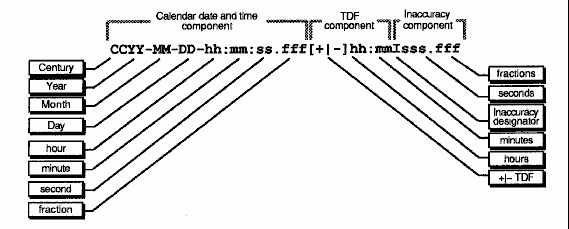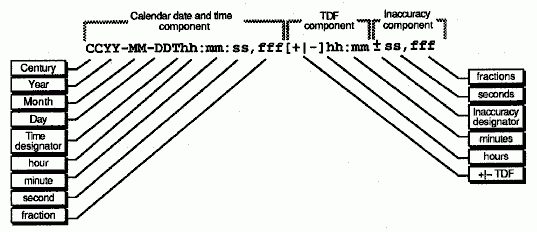Absolute Time
An absolute time is a point on a time scale. For DTS, absolute times reference the UTC time scale. Absolute time measurements are derived from system clocks or external time-providers. When DTS reads a system clock time, the time is recorded in an opaque binary timestamp that also includes the inaccuracy and other information. When you use the DCE control program's (dcecp) clock show command to display an absolute time, it is converted to ASCII text, as shown in the following display:
1993-11-21-13:30:25.78523-04:00I010.0825
DTS displays all times in an ISO-compliant format. The International Organization for Standardization (ISO) format that generated the previous display example is detailed as shown in the following figure.
ISO-Compliant Time Format

In the format example shown in the preceding figure, the relative time preceded by the + (plus sign) or (minus sign) indicates the hours and minutes that the calendar date and inaccuracy are offset from UTC. The presence of one of these characters in the string also indicates that the calendar date and time are the local time of the system, not UTC. The delineator I indicates the beginning of the inaccuracy component that is associated with the time. You can express the DTS time that you want to display in several ways. The DTS time BNF format is defined in Appendix D.
Although the dcecp program's clock show command displays all times in the previous format (see the figure above), the interface also accepts the following variations to the ISO format on input, as shown in the following figure.
ISO-Compliant Time Format Variation

In the preceding example, the delineator T separates the calendar date from the time, a , (comma) separates seconds from fractional seconds, and the ± (plus-or-minus sign) indicates the beginning of the inaccuracy component.
DTS offers a translation feature that changes UTC-based absolute times to your local time whenever the time is displayed. The local time displayed is derived from UTC plus a Time Differential Factor (TDF), which can have a positive or negative value. In the previous example, the string [+/] hh:mm denotes the TDF. When installing a system, you select a time-zone rule for the system, which determines the TDF and any seasonal changes to the TDF. After the initial startup, all subsequent output times reflect the local time. If an absolute time is displayed by your system, and it does not contain TDF information, it is a UTC time.
The following topic describes relative time, which is derived from absolute time.